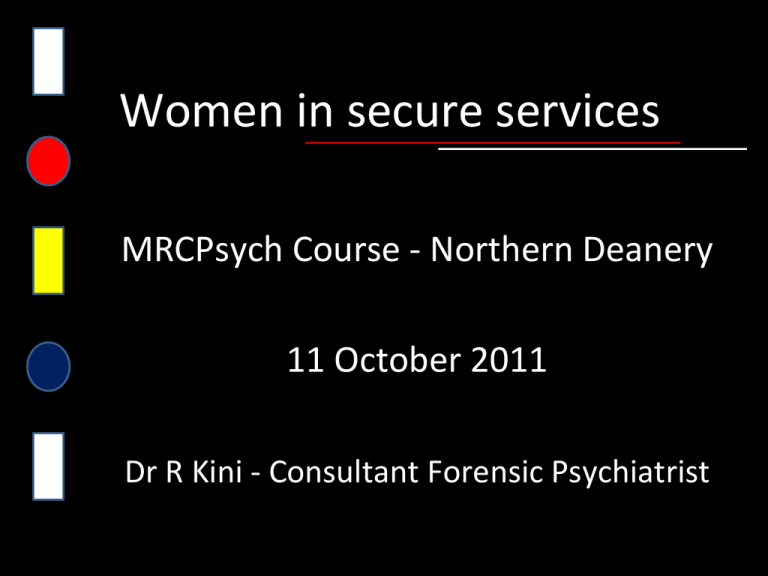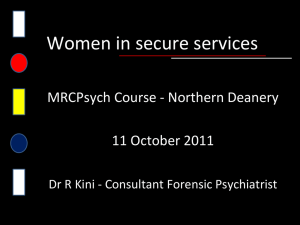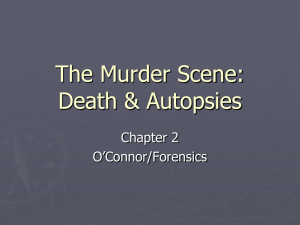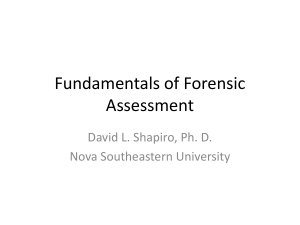
Women in secure services
MRCPsych Course - Northern Deanery
11 October 2011
Dr R Kini - Consultant Forensic Psychiatrist
Aim
To provide an overview of
key issues relating to the
assessment and
management of female
mentally disordered
offenders in secure hospitals
Objectives
Secure Services
– Policy Drivers
– Clinical characteristics
– Offence characteristics
– Gender specific needs
– Risk assessment and
management
–
SECURE SERVICES
High
Low
Woman
WEMSS
Medium
FEMALE SECURE PATHWAYS
NATIONAL HIGH SECURE SERVICE - RAMPTON
NHS
MSU / LSU
WEMSS
Orchard Clinic
(London)
Arnold Lodge
(Leicestershire)
Edenfield unit
(North West)
Supported
Placements
Community
PRISON
Independent
Sector
MSU / LSU
PICU
Non-forensic
Low Secure
Types of security
– Least restrictive environment, safe,
local
– Environmental (Physical)
– Relational (Quantitative,
Qualitative)
– Procedural (Policies, practices)
– H G Kennedy (2002) “Therapeutic
uses of security: mapping forensic
mental health services by stratifying
risk”; APT, vol. 8; pp 433-443
POLICY
DRIVERS OF CHANGE
Policy Drivers
• Butler report – 1975
• Reed report – 1992
• Set the principles
which underpinned
development of
secure psychiatric
services
• 1998 audit – 94%
wards mixed gender
• 1999: National
Women’s project group
• 2000: DoH published
Secure Futures for
Women: Making a
difference – women
centred services should
be available in hospital
and community
Policy Drivers 2
• Tilt report – 2000
• Review of security at high security
hospitals
• Highlighted the fact that 33% no longer
required HS
• TILT Funding – increase development of
RSU
• NHS Plan – 2000 Aimed for 400 transfers
nationally; Accelerated Discharge
Programme
Policy Drivers 3
• ADP completed by April 2005
• Women’s mental health: Into the
mainstream (DoH, 2002)
• Mainstreaming gender and
women’s mental health:
Implementation guidance (DoH,
2003)
Policy Drivers 4
• Women at risk: The mental health
of women in contact with the
judicial system (CSIP, 2006)
• Corston Report – 2007, Government
response
Baroness Corston’s Report – March
2007
A report by Baroness Jean
Corston of a review of
women with particular
vulnerabilities in the
criminal justice system
Policy Drivers 5
• PSO 4800 – 2008
• NSF: Improving
services to women
offenders, MoJ /
NOMS (2008)
• Standards and
Criteria for women
in medium secure
care – RCPsych,
Quality Network for
Forensic Services
(Tucker, S and Ince,
C); 2008
• Bradley Report –
2009
Lord K Bradley’s Report – April 2009
Lord K Bradley’s Report – April 2009
• Review of people
with mental health
problems or LD in
the CJS
• Early intervention
• All stages of the
CJS
• Emphasis on
diversion
• NHS & CJS working
together
Improving Health Supporting Justice
• The national delivery
plan of the Health &
Criminal Justice
Programme board
• November 2009
• System reform to
maximise opportunities
for improvement
• Right treatment at the
right time
• Better working
practices
• Innovation
• No new resources
New Horizon:
“Towards a shared vision for mental
health”
7 December 2009
A ten year strategy
Improve the mental
well being of the
population
Improve quality &
accessibility of
services for people
with poor mental
health
Key Issues
•
•
•
•
•
•
Gender sensitivity
Over containment
Nature of treatment offered
Security, Safety – Single sex accommodation
Complex needs
Staffing composition – e.g. Female to male
staffing ratio (70% proposed)
• A Bartlett; Health Inequalities & Women in
contact with the CJS
SHSA (1995) Figures
1995
Ratios
Of
F:M
Total
Prison
Low
Medium
High Note
1085
202
539
89
255
20% of the
total
population
requiring
such care
1:2
1: 4 – 1: 7
1:5
Higher
proportion of
women in
HS; higher
proportion
with PD;
relatively less
serious
convictions in
women in HS
Secure Services for Women
• 2000: Out of 39 MSU (342 beds) only 14
NHS and 79 IS beds in women only
services
• 2003: DoH paper – creation of enhanced
MSU for women in HSS who did not
need Category B high secure care
• 2008: HSS beds fell from 345 (1991) to
50 in Rampton
• 2009: 27 (18 NHS and 9 IS) MSU
providing 543 (282 NHS and 261 IS) beds
Women in secure services 1
• One in 8 of patients in
• Detained under
medium or high secure
psychopathic disorder
is female
sub-category (21% cf
12% men)
• In July 2007, 458 (12%
of total) women were in • 51% of women with
either medium or high
restriction order were
secure conditions
detained under MI cf
70% of men
• Higher proportion of
female restricted
• Sainsbury Centre for
patients were
Mental Health, Fact-file;
2007
Women in secure services 2
• In absolute numbers, a minority
• Cf men, less than 10% on restriction orders or
sentenced prisoners
• Although about 33% patients did not need HS,
the proportion of women was higher
• Dr A B & Y H – APT; Dr Y Hassell & Dr A
Bartlett; 2001; Bulletin
Women in secure services 3
• Higher prevalence of mood disorders, more
severe manifestation of PTSD and bipolar
disorder
• Later onset of schizophrenia
• Better prognosis of schizophrenia
• Amongst PD population – more diagnoses of
histrionic and dependent personality
disorders. However, rate of BPD is the same in
both genders overall! Paranoid and Antisocial
high in men
Women in secure services 4
• In high and medium
security greater
proportion under Part 2
of the Act
• Greater proportion
likely to receive hospital
disposal at Court
• The conviction in
majority – arson
• Most victims – own
children or intimate
others
• Less likely violent and
sexual offences
• Less likely to have precons and to reoffend
• 2009 study (Sahota)–
More violence than
men after discharge (2
and 5 yrs); mainly arson
– increased with time;
lower reconviction rate
• J Sarkar & M di Lustro
(2011, APT, 17, 323-31)
Female patients in HSS
• More likely than male
patients to be:
• Detained under Part 2
of the Act
• Be classified as having a
PD, especially
borderline PD
• Have an index offence
of arson
• Be admitted in the
context of suicidal or
• DSH behaviour,
aggression towards
hospital staff or damage
to property
• Higher rates of physical
or sexual abuse
• Bartlett & Hassell, APT
(2001), VOL.7, p. 304
Characteristics of female patients in secure
forensic services
• More likely to have a primary diagnosis of PD,
especially BPD; cf men who are more likely to
have a diagnosis of ASPD and Schizoid PD both
in HS and in MS
• Women admitted to secure forensic
psychiatry services: I. Comparison of women
and men (J Coid et al; The Journal of Forensic
Psychiatry; Vol 11; No. 2; September 2000;
275 – 295)
• Cluster analysis article – pp 296 – 315
Characteristics of female patients
in secure forensic services 2
• More likely than male patients to:
• Be admitted as transfers from other hospitals
• Have a charge or conviction of arson or
criminal damage
• Have fewer criminal convictions and more
previous Ψ admissions
• More likely to have diagnosis of depression,
phobia, anxiety / panic, epilepsy and IQ < 70
in MSU and Depression & other in HSH (cf
Schizophrenia in men)
Characteristics of female patients
in secure forensic services 3
• Using Cluster analysis:
• 7 year study of 3 HS hospitals and MSU from 3
regions (1988 – 1994)
• 7 clusters: 3 PD (ASPD, BPD, Other PD); 3 MI
(Schizophrenia, Mania and Depression); 1 OBS
• ASPD Cluster – Significant co-morbidity with
BPD; with criminal behaviour (arson, CD,
theft); higher rates of admission to HS; precons linked with major violence and Part 3
admissions
Characteristics of female patients
in secure forensic services 4
• BPD Cluster – Increased • Schizophrenia cluster –
criminal behaviour
34%
(arson and minor
• Larger proportion – non
violence), epilepsy,
UK Born, index more
substance misuse,
likely to be major
previous Ψ admissions
violence but not
• Mania Cluster – Violent significant previous
behaviour in other
violent offending, part 2
hospital settings
admissions,
• Depression cluster –
26% after homicide
Characteristics of female patients
in MSU 1(Sahota et al, 2010)
• Retrospective Study – •
20 year follow up of all
first admitted patients
discharged from Arnold •
Lodge between 1983
and 2003
• Compared 502 men
•
admitted with 93
women
Women more likely to
be admitted to MSU
from other hospitals
More likely to be on
civil sections and
without index offence
More likely to have
committed arson but
less likely – violence or
sex offence
Characteristics of female patients
in MSU 2(Sahota et al, 2010)
• Less likely than men to have h/o drug misuse
despite being more likely to have PD (BPD)
• Odds of reconviction after discharge about half
as that of men
• Higher rate of mortality, readmission
• Higher rate of violent behaviours and arson
(without significantly increased conviction
rates) were noted post discharge
CBT Group Interventions
•
•
•
•
Dealing with feelings
Interpersonal effectiveness
Social problem solving
Overcoming substance use problems and
preventing relapse / P ASRO
• Living with Schizophrenia
• The development of a “best practice” service
for women in a medium secure psychiatric
setting: Treatment components and
evaluation; C Long et al; Clin Psychol
Psychotherapy; 15; pp 304-319; 2008
Interventions
• Offence focussed: Life Minus Violence; Arson
treatment (e.g. Phoenix programme)
• Choices, Actions, Relationships, Emotions
(CARE – Sue Kennedy)
• Individual offence focussed work
• Lucy Faithful foundation – Sex offender work
• DBT – M Linehan – Treatment for Borderline PD
• Trauma focussed CBT, EMDR (Shapiro) – NICE
• Maxine Harris – Trauma Recovery &
Empowerment Model (TREM)
• Rampton – Trauma and Self Injury (TASI) model
Risk & Other Assessments
HCR – 20
START
VRS
VRS – SO
PCL-R
CAPP
Treatment Interventions
Medication
Offence
Focussed
Family
Oriented
Ward Milieu
PD
Focussed
Psychotherapy
Trauma
Focussed
Offender pathway
REMAND
CONVICTION
•Fitness to be
interviewed
•Fitness to plead
•Partial defences
•s 35, 36, 48
• Dangerousness
within meaning
of the CJA 2003
•s 38
SENTENCE
•Report for
disposal
•s 45, 37/41
Dangerous and Severe Personality Disorder (DSPD)
Primrose Programme
Primrose DSPD programme
• National service
• 12 places
including 1 RS
• Based at HMP
Low Newton,
Durham
Service Model
Inclusion Criteria
• Women aged 18 years or
more
• A minimum of 3 years left
of sentence to serve with
no current or pending
appeals
• High risk of serious harm to
others (e.g. violence,
arson, cruelty to children)
• Severe PD linked to
offending behaviour
• IQ – able to participate in
psychological treatment
Case Vignette 1
Synopsis
• 32 year old foreign
• Significant stresses of
national
parenting, stigma of
mental illness
• Professional
• History of depression
• No previous offending
and post natal
• Significant psycho-social
depression
stressors (e.g. Marital
• Killed 11 months old
difficulties, financial
baby and attempted
hardships, bullying /
suicide
racial harassment, poor
social support
Discussion
• Interface issues
– Assessment by general
psychiatrist
– Emergency secure bed
• Knowledge of CJS
procedures
– Fitness to be
interviewed
• Offender pathway
– Assessment in prison
– Referral to secure unit
– Gate-keeping
• Mental Health
Legislation
– Sections
– Partial defences
– Repatriation laws and
rules
• Ethical / moral dilemma
References
• Kaye, Charles (1998) Hallmarks of a secure
psychiatric service for women. Psychiatric
Bulletin. 22: pp 137-139
• Bartlett A and Hassell Y (2001) Do women need
special services? Advances in Psychiatric
Treatment , vol.7, pp. 302 – 309
• Hassell Y and Bartlett A (2001) The changing
climate for women patients in medium secure
psychiatric units. Psychiatric Bulletin, 25: pp
340 -342
References
• Coid J et al (2000) Women admitted to secure
forensic psychiatry services: I. Comparison of
women and men. The Journal of Forensic
Psychiatry, Vol. 11, No. 2, September, pp 275295
• Coid J et al (2000) Women admitted to secure
forensic psychiatry services: II. Identification of
categories using cluster analysis. The Journal
of Forensic Psychiatry, Vol. 11, No. 2,
September, pp 296-315
References
• Kennedy, HG (2002) Therapeutic uses of
security: mapping forensic mental health
services by stratifying risk. Advances in
Psychiatric Treatment, Vol.8, pp 433-443
• Long CG; Fulton, B; Hollin, CR (2008) The
development of a ‘best practice’ service for
women in a medium-secure psychiatric
setting: Treatment components and
evaluation. Clinical Psychology and
Psychotherapy; 15, pp 304-319
References
• Sahota, S (2010) Women admitted to Medium
Secure Care: Their admission characteristics
and outcome as compared with men.
International Journal of Forensic Mental
Health; 9: pp 110-117
• G Parry-Crooke (2009) My Life: in safe hands?
Summary Report of an evaluation of women’s
medium secure services; London Metropolitan
University









